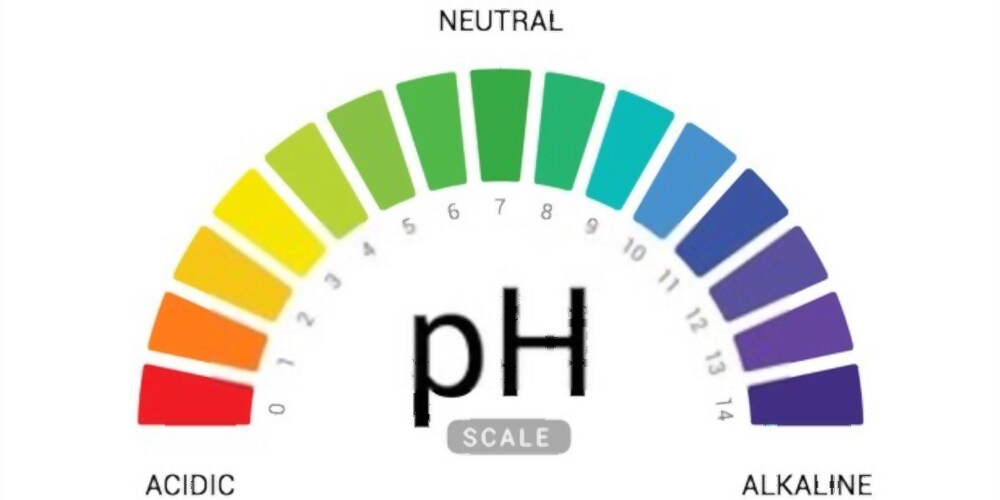Soil acidity is the term used to express the quantity of hydrogen (H) and aluminum (Al) cations (positively charged ions) in soils. When levels of hydrogen or aluminum become too high—and the soil becomes too acid—the soil’s negatively charged cation exchange capacity (CEC) becomes “clogged” with the positively charged hydrogen and aluminum, and the nutrients needed for plant growth are pushed out. Acidic soils create production problems by limiting the availability of some essential plant nutrients.
Below soil pH 5.5 (pH is the measurement of soil acidity. The lower the pH, the higher the soil acidity), aluminum may be concentrated enough to limit or stop root development. As a result, plants cannot absorb water and nutrients, are stunted, and exhibit nutrient deficiency symptoms.
Factors Causing Soil Acidity
Rainfall and leaching
Soils usually become acidic under heavy rainfall. This is because rainwater is slightly acidic (about 5.7) due to a reaction with CO2 in the atmosphere that forms carbonic acid. As this rainwater passes through soil pores, it leaches basic cations from the soil as bicarbonates, which increases the percentage of AI3+ and H+ relative to other cations in the soil. Root respiration and decomposition of organic matter by microorganisms also release CO2 that increases the carbonic acid (H2CO3) concentration resulting to leaching.
Nitrogen fertilizers
Some fertilizers such as ammonium (NH4+) fertilizers undergo nitrification process to form nitrate (NO3−), and during this process, H+ ions are released leading to acid soils. The more ammoniacal nitrogen fertilizer is applied, the more acidic the soil gets.
Parent material
Due to differences in chemical composition of parent materials, soils will become acidic after different lengths of time. Thus, soils that developed from granite material are likely to be more acidic than soils developed from calcareous shale or limestone.
Organic matter decay
Decaying organic matter produces H+ which is responsible for acidity. The carbon dioxide (CO2) produced by decaying organic matter reacts with water in the soil to form a weak acid called carbonic acid. Several organic acids are also produced by decaying organic matter, but they are also weak acids.
Crop production
Harvesting of crops has its effect on soil acidity development because crops absorb the lime-like elements, as cations, for their nutrition. When these crops are harvested and the yield is removed from the field, then some of the basic material responsible for counteracting the acidity developed by other processes is lost, and the net effect is increased soil acidity.
Increasing crop yields will cause greater amounts of basic material to be removed. Grain contains less basic materials than leaves or stems. For this reason, soil acidity will develop faster under continuous wheat pasture than when grain only is harvested. High yielding forages, such as bermudagrass or alfalfa, can cause soil acidity to develop faster than with other crops.
How is soil acidity corrected?
HUMIPOWER® , a soil conditioner, is also used for acidic soil amendments particularly with acidifying fertilizers when mixed at a rate of 1 kg for every 50 kg bag of basal fertilizer. Not only does it amend acidity but also helps in nutrient uptake.
HUMIPOWER® is a water soluble soil amendment and blend that contains potassium, Iron EDDHA, humates and fulvic acid in granular form. It is used in agricultural, horticultural and field crops, landscaping lawns, pot plants as well as gardening. It is used both in the soil as an amendment and as fertilizer blend and supplies plants with organic matter that is readily available, easy to use and cost effective.
Soil acidity can also be corrected easily by liming the soil, or adding basic materials to neutralize the acid present. The most commonly used liming material is agricultural limestone, the most economical and relatively easy to manage source. The limestone is not very water-soluble, making it easy to handle. As lime dissolves in the soil, calcium (Ca) moves to the surface of soil particles, replacing the acidity. The acidity reacts with the carbonate (CO3) to form carbon dioxide (CO2) and water (H2O). The result is a soil that is less acidic (has a higher pH). Lime also supplies essential nutrients, makes other essential nutrients available and prevents elements such as magnesium and aluminium from being toxic to plants.






